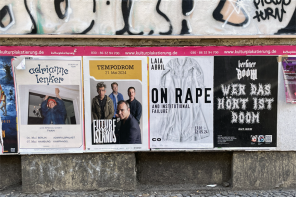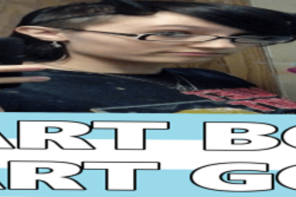Sentient. This is the word that resonates with me after my meeting with American multimedia artist Melissa Steckbauer, and it describes her perfectly. During our meeting, she laughed many times and cried twice. She helped me relax my soul and my throat. We talked about feelings.
What characterises humans as social beings? How do communities arise? What do we need in order to feel safe and secure in our surroundings? “The Sonancy of Falling and Standing Repeatedly“, Steckbauer’s solo exhibition, transforms Galerie im Turm into an experiential workshop, a sensory playground, a celestial site and an intimate witches’ hut; a place to localize and expand notions of sensuality.
The title of the exhibition refers to consciousness. It is an utterance or a breath, repeatedly opening and closing on itself. We remember, stand, feel firm and grounded in some awareness and then rhythmically fall—into systems, traps of the imagination, and physical difficulties. It is a process that we engage in continually. “We could be having so much fun, this could be ecstasy”, she says with a bright smile. All the time that we spend looking for prestige and a prescribed, outside sense of value is separating us from our own feelings. What should we do about that? “Reclaim your body”, she says. She doesn’t hesitate.
Steckbauer believes that ecstasy is possible through connection. In her new work, she aims to create a space, a cocoon really, where we can reconnect with ourselves and others. The approach is to get inside the body and to exercise affection and vulnerability from within. Her emphasis is on the empathy of the particular, acquired by listening to the world around us, but her work can also be investigated on olfactory and tactile, as well as auditory levels.
In her artistic process, one of the questions that arose was whether it is actually possible to create a safe space to experience emotion and vulnerability within the institutional framework of the Galerie im Turm, a facility of the Cultural Department of the Bezirksamt Friedrichshain-Kreuzberg.
Steckbauer believes that institutional architecture lacks humanity. There is a need, and, in the case of her exhibition, a challenge, to create room to lay down and relax, to just take time. She worries that the human connection cannot happen, that we will not be able to enjoy ourselves, that there won’t be enough beds, that the connection won’t be long enough, deep enough. That real surrender might not happen.
The support of curator Sylvia Sadzinski, who is, in Steckbauer’s words, a strong woman who is not afraid to say what she thinks (and to whom Steckbauer feels very connected), enables the exhibition to emphasize community gatherings and exchanges. The exploration of sensitivity and softness are key points of the artistic and curatorial focus, allowing these moments of intimacy and affinity to arise. The work that she presents in “The Sonancy of Falling and Standing Repeatedly” has a haptic inclination. Embroidered textile elements, such blankets, cushions and carpets cover the space. The forms of soft, human bodies are recognizable on them. Ropes hanging from the ceiling are reminiscent of queer and/or BDSM play parties.
The textiles follow a thread from her earlier work, which was an homage to the culture and communities she is a part of. “There is a nod to the divine feminine, to pagan, queer, trans, and sex-positive cultures, but it’s as much about my grandmother who taught me to quilt and folks who make things privately with their hands that bring comfort and haptic pleasure to the people they love and care for,” she explains. She goes on to say that creating them was a meditative process that put her into almost a state of hypnosis by repetition.
Her creative practice is also always changing in response to her social environment. For Steckbauer, “human connection is the cake and the exhibition is only the frosting,” and there have been and will be many events through the 2-month exhibition, like a discussion in the round about the notion of shame and its hidden power. “I see shame as tied deeply to embodiment and one of the doors to intimacy. But there are diverse forms that this single affective norm takes, e.g., it can be an essential tool for harm reduction in the social sphere or it may be a disabling form of pain built upon a false idea of self and/or community. Whereas some behavior will induce exile in my tribe, it may be celebrated in others. I see a macroscopic view as essential when dealing with our internalization of shame and its power, bearing in mind its relativistic nature.”
The Sensorium, a participatory performance, is a pivotal element in the project. The last session will take place May 6th, and, according to the Facebook event, the Sensorium explores the non-erogenous nature of interpersonal contact, collective creativity, and relaxing in the company of others. The fundamental element is the giving and receiving of positive attention, communicating our wishes and boundaries, and having those requests enacted. Sessions are aimed at broadening creativity and sensual contact to the material world. A central aspect of this practice is touch; however, touch is not a mandate for participation, as each session is built around the wishes and needs of the group. The work may also be grounded in elements like a change in temperature, aroma, aural sensation, and speech. “I see the Sensorium as a tool for bringing us home to our bodies and thus, closer to our dormant feelings within them, as with shame. I also see the need to read and converse about those elements which may dangle at the periphery of our circles, but be essential for a neighboring tribe; thereby lessening the harm done by inaction,” she adds.
My last question focuses on self-care and alternative health techniques and my concerns about capitalist appropriations. I ask Steckbauer if she shares my worries and if she has tools for resisting. She elaborates on this, saying, “I think we’re desperate for positive attention, care, gestures of self-love, a deepening of intimacy, and an increased sense of loyalty—more to the point, a feeling that we are more important than the bursts and small fires that can be set by capitalism. I see a little bit of poison in much of the medicine so I can’t always tell where appropriation ends and healthy action begins; mostly because by now we’re all guilty, it’s just a matter of degree. But to usurp the anxiety and urgency of money making, to decentralize systems oriented toward the exploitation of desire and the valuation of affluence we have to celebrate the ridiculous, weak, and highly vulnerable among us, beginning with those qualities that exist within ourselves. The most radical acts of self-love are needed now. For me, it’s less about resisting the one and more about deepening the other. Slowing processes down to take them in through the body, filtered by emotion. Breakdowns are great signifiers, be they economic, social, or individual.”
As I leave Steckbauer’s cocoon behind, I suspect she has worked her magic on me. I feel the liberation that comes with surrender. I breathe it in.
“The Sonancy of Falling and Standing Repeatedly” can be visited until May 13th 2018 at Galerie im Turm.
Interview by Lorena Juan
Photos by Eric Tschernow, courtesy Galerie im Turm
Melissa Steckbauer was born in Tucson, Arizona in 1980 and has studied Art History at the University Utrecht, Fine Art at the University of Wisconsin-Madison, and Reiki with Katherine Borkenhagen in central Wisconsin. Steckbauer is the creator of the Sensorium, the founding director of the experimental project space The Wand, a freelance writer, and a cofounder of Secondary Narratives. Her work has been featured in Castello di Rivoli—Museum of Contemporary Art, Rivoli; KW, Institute for Contemporary Art, Berlin; Deutsch Bank KunstHalle, Berlin; Latvian Centre for Contemporary Art, Riga; Teatr Studio at the Palace of Culture & Science, Warsaw; Skopia Art contemporain, Geneva; District, Berlin; Kunstsaele, Berlin; Le Salon Du Dessin, Paris; Cité internationale des Arts, Paris.
Lorena Juan is a writer and curator living in Berlin. Juan works transdisciplinarily with gender, feminism, and decolonization, as well as body politics and intercultural issues. She has curated several exhibitions and events focusing on these topics with varied programs that mix art media, academics, and social activism. Juan is also the co-founder and artistic director of the queer feminist artists’ platform and collective COVEN BERLIN.





















